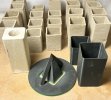| Monthly Tech-Tip | No tracking! No ads! | |
Operation timed out after 2000 milliseconds with 0 bytes received
Error: API server returned an invalid response for projectMaking our own kiln posts using a hand extruder
Posts don't need to have thermal shock resistance like shelves do. And they don't need to be as refractory. They don’t require tensile strength. And they don't require powerful pressing or extruding equipment to make them. Any potter who is mixing glazes or clay bodies already has the materials to make them.
3-D printing has suddenly made it easy to extrude round or square or even complex hollow shapes and tubes. This is possible because it is now easy to make highly precise compression dies for extruders. They can be made out of a variety of metals and plastics.
Related Information
Making Your Own Heavy Duty v1 Kiln Posts
The tools and supplies needed will enable other things too

This picture has its own page with more detail, click here to see it.
Supply chain issues during Covid made it difficult to get posts. I wondered if I could make my own. I have access to the same ceramic materials that post manufacturers use. The highest temperature we fire is cone 10. In the past, it was always a hassle to make the extruder die, but not anymore. An ordinary 3D printed PLA template will easily withstand the pressure in a hand extruder (even if printed with infill). The precision of the geometry is amazing. Notice that the floating centre has a tapered bridge to help clay knit together as it flows around it. What about a refractory plastic body? I started with L4543, it is cheap to make and dries quickly with minimal shrinkage (I slurry it up using a propeller mixer and dewater on a plaster table). To cut posts to length with a square end I print sleeves to slide them into.
Inbound Photo Links
 I Just Made These Kiln Posts Using a Hand Extruder Get the v2 CAD drawing to do it yourself |
| By Tony Hansen Follow me on        |  |
Got a Question?
Buy me a coffee and we can talk

https://digitalfire.com, All Rights Reserved
Privacy Policy
